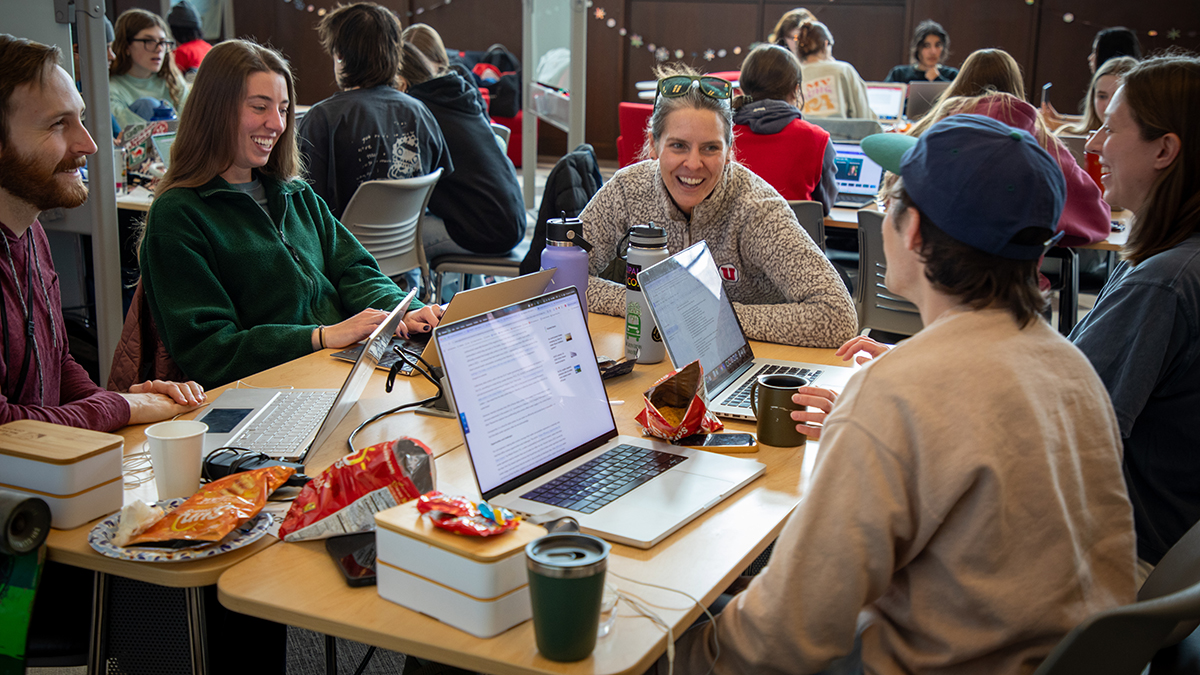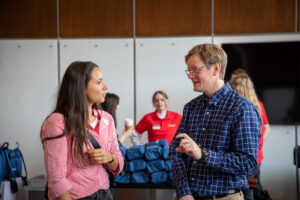
Earlier this month, five French Université Côte d’Azur graduate students and two staff leaders traveled to the University of Utah to participate in a climate solutions “hackathon” organized by the Wilkes Center for Climate Science & Policy, and co-sponsored by the Office for Global Engagement, focused on water resiliency.
The event fulfilled a newly formed U partnership with Université Côte d’Azur in Nice, France. France’s Région Provence-Alpes-Côte-d’Azur will host the 2030 Winter Olympic and Paralympic Games. Salt Lake City, Utah, will host them in 2034.
The climate solutions hackathon challenges undergraduate and graduate students from any discipline to team-up and develop proposals in a slide deck within 24 hours.
This year, the teams worked from Friday Jan. 31st until Saturday morning, Feb 1st.
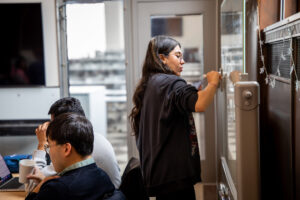
The teams of three to five had a day to propose a solution via a slide deck and short presentation promptly due the next morning. The challenge was to propose an innovative, data-driven solution in one of five categories:
- Municipal Water Supply
- Inland and Coastal Flooding
- Agriculture
- Drought
- Water and Energy Infrastructure
Gathered in a bustling event hall in Crocker Science Center, the students engaged with expert faculty from both universities and drew inspiration from a video mentoring space of adept researchers. Mentors touched on important topics; for example, the U’s Marian Rice, associate director of Peak Water Sustainability Engine, spoke on topics such as partnering to protect watersheds and opportunities for green infrastructure. With approximately 88 students participating, 17 total slide decks were ultimately submitted.
On Saturday morning the teams reassembled to pitch their ideas to their peers at the Crocker Science Center, after which the group voted for the most impressive presentations. Two teams tied for this “People’s Choice Award.”
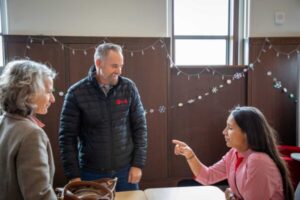
Randy McCrillis, the U’s Office For Global Engagement,
Pearl Kling, Université Côte d’Azur.
A panel of Wilkes Center staff and faculty, along with Professor Isabelle La Jeunesse from Université Côte d’Azur, deliberated over the weekend to officially select the top three proposals. Teams were evaluated according to four criteria:
- Problem definition and analysis
- Uniqueness and innovation
- Idea feasibility
- Implementation and scalability
“The ideas developed, particularly those of the finalists in this Hackathon, are realistic projects and thus potentially feasible,” said La Jeunesse. “It is therefore entirely possible that some of them will decide to get involved in developing their project, which would be fantastic given the great need in this field.”
The winners are listed below.
First place ($3,000)
SmartFLOW City Program
“Bridging the gap between cutting-edge science and water resource management”
- Sam Carter (graduate student, hydrogeology)
- Baylee Olds (PhD student, snow hydrology)
Tyler Yoklavich (graduate student, hydrogeology)
The SmartFLOW team tackled the issue of municipal water supply. They identified three main challenge areas for water in cities: water forecasting, sustainable water management, and consumptive use. According to the students’ program, cities could obtain “SmartFLOW Certification” if they abide by precise criteria in all three areas, including bronze, silver, and gold level certifications. The team provided incredibly specific implementation plans such as detailed funding propositions and a water monitoring and data app.
“It’s funny, we all share an office together, but we’ve never gotten to collaborate like this,” said Sam Carter. “The hackathon forced us to talk about important issues and integrate our individual research into something special.”
The SmartFLOW City Program could be a strong incentive for cities to strengthen their water infrastructure; team members suggest, “SmartFlow Cities will also be able to leverage certification as a badge of climate resiliency, a selling point for courting large events like the Olympics, and for promoting sustainable growth.”
“I really liked the event, more than I thought I would,” said Carter. “We went into it thinking we were going to spend six hours working and call it good. We ended up working threefold what we thought we would because we were super invested.”
Yoklavich agreed that they, “totally got sucked in.”
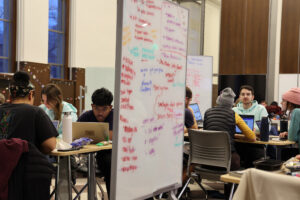
“In academia, we spend a lot of time thinking about very niche problems for a very long time. A master’s thesis or a Ph.D. is like one tiny little slice. The hackathon forced us to think about issues more broadly, which proved to be super helpful and interesting.”
Second place ($2,000)
GreenSight
“Visionary watering for a smarter lawn”
- Clement Chatelain (Université Côte d’Azur)
- Isabella DeBoer (undergrad, computer science)
- Delia Leonard (undergrad, computer science)
- Bode Packer (undergrad, computer science)
- Jaxon Smith (undergrad, computerscience)
The GreenSight team tackled the issue of drought, specifically with regards to watering lawns. GreenSight’s presentation opened with a shocking statistic: Of the 2.23 trillion gallons of water that U.S. households use on their lawns every year, half of that is wasted (1.11 trillion). As climate change brings more extreme weather patterns, sustainable water use becomes more of a pressing concern.
As such, Greensight proposed a new product for American consumers. Comparable to the cost of a Ring Camera, Americans could purchase a special camera that monitors their lawn over time. The GreenSight algorithm would then process this data to determine and implement an optimal watering schedule, reviewable via an accessible app. By integrating the technology into existing sprinkler systems, households could save around 15,000 gallons on their water bill, as well as drastically reduce nationwide water consumption, one home at a time.
“After throwing out idea after idea for a few hours, we found that starting small is a much more feasible way to tackle any issue,” said Delia Leonard. “That’s what led us to lawns.”
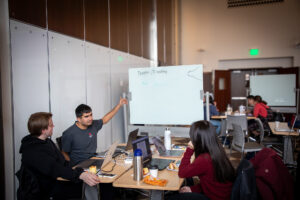
Leonard added that their team entered the competition with hesitancy. “Going into the event, we were just counting on having a good time with friends. After we left Saturday morning, we’d seen the voting results and we were like, ‘Maybe we actually did something exciting.”
Third place ($1,000)
PhosCycle
“Selectively capturing phosphate in water, and converting it to fertilizer”
- Thibaut L. M. Martinon (graduate student, chemistry)
- Maria I. Quiros (graduate student, chemistry)
- Zinan Yu (graduate student, chemistry)
- Maryam Amirpour Nobles (graduate student, chemistry)
The PhosCycle team tackled the issue of agriculture, specifically nutrient scarcity and pollution. Team member Thibaut Martinon explained, “We came into the project agreeing to want to address something more niche… no one has cared for issues like nutrient pollution despite its critical situation in the U.S.”
A considerable amount of freshwater in the United States is affected by nutrient pollution from fertilizer. Nutrient pollution can compromise the safety of drinking water for American communities, and managing it is tremendously expensive.
To help clean up our water, the PhosCycle proposes to implement phosphate-capturing buoys. Their innovative design would be much more effective than conventional methods, and it includes a revolutionary perk: PhosCycle’s buoys would allow captured phosphates to be reused. This approach would save farmers billions of dollars on fertilizer each year, as well as purify the water resources of millions.
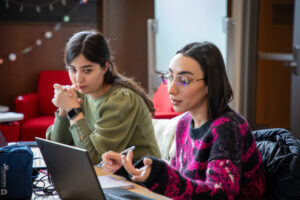
“The hackathon taught us a great deal about fast-paced problem-solving, teamwork, and adaptability under pressure,” said Maryam Nobles. “One of the most surprising takeaways was realizing how much we could accomplish in just 24 hours—something new for most of us. It also provided a valuable perspective on how academic research can be translated into real-world applications, industrialized, and structured to attract funding for underexplored yet critical issues.”
1st People’s Choice Award
“GreenSight”
- Clement Chatelain (Université Côte d’Azur)
- Isabella DeBoer, undergrad, computer science)
- Delia Leonard, (undergrad, computer science)
- Bode Packer, (undergrad, computer science)
- Jaxon Smith, (undergrad, computer science)
2nd People’s Choice Award
“Blue Roots Alliance”
- Jasmine Malhi, (undergrad, criminology/political science)
- Chase Canning, (undergrad, data science)
- Nathan Murthy, (undergrad, earth & environmental science)
- Savannah Jordaan (undergrad, environmental & sustainability studies/business)
- Alta Fairbourne (undergrad, sociology)
All of the proposed solutions can be viewed on the Wilke’s Center Hackathon webpage.

